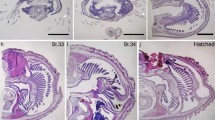Summary
There are groups of epidermal organs in the head region of Morulius chrysophakedion. In contrast to the superficial perlorgans of some other Cyprinidae these organs are formed by an infolding of epidermis into the connective tissue beneath. From this tissue vessels reach into the interior of the organ. Electron microscopical and histochemical data give evidence of a relatively high metabolic activity in the “Polsterzellen” from which the organ is built up. These cells give rise to a keratinized area at the top of the organ. There is no evidence that the epidermal organ has the function of a sense organ as in the organs of Fahrenholz in Dipnoi and Brachiopterygii.
Zusammenfassung
Im Kopfbereich von Morulius chrysophakedion liegen epidermale Organe in Gruppen beisammen. Im Gegensatz zu den oberflächlichen Perlorganen anderer Cyprinidae handelt es sich hierbei um voluminöse Einsenkungen der Epidermis in das darunter gelegene Bindegewebe, von dem aus gefäßführende Papillen in das Organinnere hineinziehen. Elektronenmikroskopische und histochemische Befunde sprechen für eine relativ hohe Stoffwechselaktivität der das Organ aufbauenden Polsterzellen, als deren Ergebnis eine Art Verhornung an der Organspitze vorliegt. Hinweise auf eine Funktion der epidermalen Organe von Morulius als Sinnesorgane wurden nicht gefunden; sie müssen daher von den Fahrenholzschen Organen der Dipnoi und Brachiopterygii unterschieden werden.
Similar content being viewed by others
Literatur
Adam, H., Czihak, G.: Arbeitsmethoden der makroskopischen und mikroskopischen Anatomie. Stuttgart: G. Fischer, 1964.
Aisa, E.: I tubercoli nuziali in Rutilus rubilio Bp. var. rubella (trasimenicus) Bp. del Lago Trasimeno. Boll. Zool. 26, 601–606 (1959).
Arnold, M.: Histochemie. Einführung in Grundlagen und Prinzipien der Methoden. Berlin-Heidelberg-New York: Springer 1968.
Bertin, L.: Peau et pigmentation. In: P. Grasse, Traité de Zoologie, Poissons, p. 433–458. Paris: Masson & Cie. 1958.
Branson, B. A.: Observations on the breeding tubercles of some Ozarkian minnows with notes on the barbels of Hybopsis. Copeia (Philad.) 1962, 532–539 (1962).
Dotterweich, H.: Bau und Funktion der Lorenzinischen Ampullen. Zool. Jb. Abt. allg. Zool. u. Physiol. 50, 347–418 (1932).
Friedrich-Freksa, H.: Lorenzinische Ampullen bei dem Siluroiden Plotosus anguillaris Bloch. Zool. Anz. 87, 49–66 (1930).
Grassé, P.: Traité de Zoologie, t. 13. Paris: Masson & Cie. 1958.
Harder, W.: Anatomie der Fische. Stuttgart: E. Schweizerbart 1964.
Huntsman, G. R.: Nuptial tubercles in carpsuckers (Carpiodes). Copeia (Philad.) 1967, 457–458 (1967).
Jakubowski, M. O.: Note on pearl organs of the stone loach, Noemacheilus barbatulus (L. 1758) (Osteichthyes, Cobitidae). Acta soc. zool. Bohemoslow. 31, 25–27 (1967).
Koehn, R.: Development and ecological significance of the red shiner, Notropis lutrensis. Copeia (Philad.) 1965, 462–467 (1965).
Matthes, H.: Poissons nouveaux ou intéressants du lac Tanganyika et du Ruanda. Ann. Mus. roy. Afr. Centrale Zool. No. 111, 27–88 (1962).
Maurer, F.: Die Epidermis und ihre Abkömmlinge. Leipzig: Wilhelm Engelmann 1895.
Pfeiffer, W.: Die Fahrenholzschen Organe der Dipnoi und Brachiopterygii. Z. Zellforsch. 90, 127–147 (1968).
Ramaswami, L. S., Hasler, A. D.: Hormones and secondary sex characteristics in the minnow, Hyborhynchus. Physiol. Zool. 28, 62–68 (1955).
Romeis, B.: Mikroskopische Technik, 16. Aufl. München u. Wien: Oldenbourg 1968.
Roux, J.: Note sur un reptile scincoide des îles Salomon présentant des pores pédieux. Verh. Nat. Ges. Basel 41, 129–135 (1930).
Schnakenbeck, W.: Pisces. In: W. Kükenthal, Handbuch der Zoologie, Bd. 6. Berlin: W. de Gruyter & Co. 1955 u. 1960.
Smith, H. M.: The fresh-water fishes of Siam, or Thailand. U. S. Nat. Museum Bull. (Wash.) 188 (1945).
Tozawa, T.: Studies on the pearl organ of the goldfish. Annot. Zool. Japan (Tokyo) 10, 253–263 (1923).
Author information
Authors and Affiliations
Additional information
Mit Unterstützung durch die Deutsche Forschungsgemeinschaft.
Rights and permissions
About this article
Cite this article
Sasse, D., Pfeiffer, W. & Arnold, M. Epidermale Organe am Kopf von Morulius chrysophakedion (Cyprinidae, Ostariophysi, Pisces). Z. Zellforsch. 103, 218–231 (1970). https://doi.org/10.1007/BF00337313
Received:
Issue Date:
DOI: https://doi.org/10.1007/BF00337313




